Memorials and Statues on Holiday
hile the leaves here in Ireland are changing colours and we’re heading for winter, I’m remembering some beautiful places we visited over the summer. During our time in Hungary and bordering countries we discovered many memorials and statues. Some dreadfully sad and others hilarious.
Memorials and statues are usually built to focus on a historic event that happened a long time ago. An atrocious happening we need to never forget. Or statues of human beings who did extraordinary things. And sometimes just impressive statues of animals or other creatures. Whatever the reason behind these statues and monuments, we encountered many on our holidays, so here are a few:
The statue of a dragon in Klagenfurt (Austria)
One of the less serious statues we came across during our travels was that of a dragon in the town of Klagenfurt, the capital of Carinthia in southern Austria, which is situated on Lake Wörthersee.
The story goes that a dragon was causing mayhem in the 13th century in Klagenfurt, with continuous floods destroying any crossings of the River Glan, threatening travellers. A reward was up for grabs for anyone who could seize the dragon.
One brave young man succeeded and in 1335 the dragon’s skull – zoologists in the 1800’s recognised that the skull belonged to an Ice Age woolly rhinoceros – was found in a quarry named Dragon’s Grave. It was displayed in the city’s town hall. Ulrich Vogelsang used it in 1590 to make this monument, but it can also be regarded as the first known reconstruction of an extinct animal. It is believed an anonymous artist carved the sculpture from a single block of chlorite slate.
Further legend says that 300 men carried the six-ton beast to the centre of town. This dragon definitely makes for interesting photographs.
Shoes on the bank of the Danube memorial (Hungary)
One of the most haunting memorials we saw on this trip was the vision of film director Con Togay and sculpted by Gyula Pauer. It compris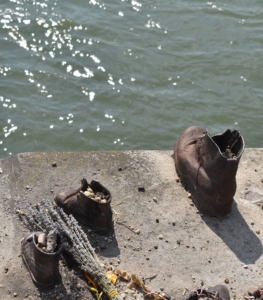 es of 60 pairs of metal shoes set in concrete on the Danube embankment close to the parliament building in Budapest, the capital of Hungary.
es of 60 pairs of metal shoes set in concrete on the Danube embankment close to the parliament building in Budapest, the capital of Hungary.
This memorial was set up in 2005. It commemorates the Hungarian Jewish people who were killed by the Arrow Cross militiamen – pro-German, anti-Semitic and national socialist party members of Hungary from 1944 to 1945. The victims were told to line up on the bank of the Danube river, execution style. Before they were shot they were ordered to take of their shoes.
During the second world war shoes were one of the most valuable items. It is such an honest and poignant memorial.
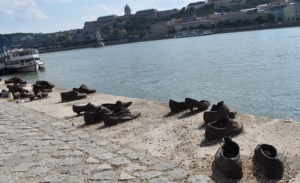
Monument of shoes on the bank of the Danube.
Statue of Gustav Mahler (Slovenia)
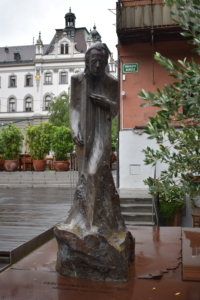
Statue of composer Gustav Mahler.
In Ljubljana, Slovenia, we came across a statue of the composer Gustav Mahler (1860-1911). In his symphonies romanticism of the 19th century is linked with modernism of the 20th century. Mahler was always regarded as an outstanding conductor in his lifetime. His compositions, however, only became more famous over the last 60 or so years. He was born into an Austrian Jewish Family in Kaliste, a village in the Czech Republic.
This statue is in the immediate vicinity of the Slovenian Philharmonic Building, and was unveiled in 2011. Mahler took up his first conducting post here as a 21-year old musician. The statue was created by sculptor Bojan Kunaver and cast by Roman Kamšek. Although a lovely sculpture, I was puzzled why it depicted an older man if Mahler came to Ljubljana when he was a young man.
Mahler eventually composed 10 symphonies, each very emotional and large in scale. He also wrote several song cycles with folk influences. His work is characterized as part of the Romanticism movement and is often focused on death and afterlife.
Statue of Saint Francis of Assisi (Villach, Austria)
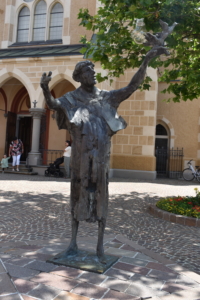
In the picturesque village of Villach, in southern Austria, we came across this wonderful statue of Saint Francis of Assisi on the Nikolaiplatz. The sculptor is Jos Pirkner and it was unveiled in 2008.
The statue pictures the Catholic friar, Giovanni di Pietro di Bernardone (1181 -1226), who also founded the Franciscans. Saint Francis of Assisi was inspired to lead a life of poverty as an Evangelist Christian. He is also associated with patronage of animals and the environment, hence the statue with doves in tattered clothes.
Villach itself is a most charming town and you can walk for hours around the old town, admiring the buildings and enjoy the culinary delights or visit some of the beautiful shops and indeed see more statues.
Until next time.
Slán
![]()

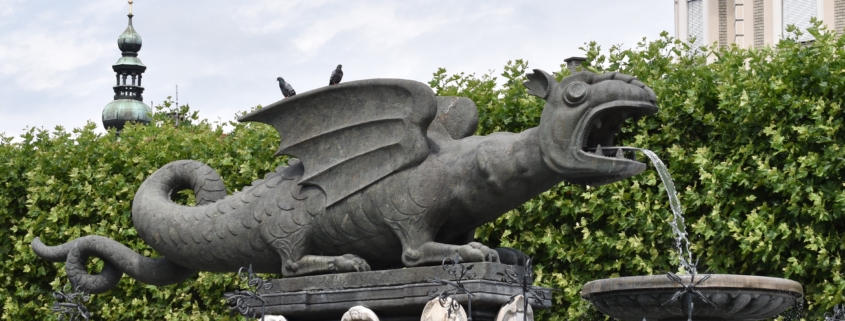
Leave a Reply
Want to join the discussion?Feel free to contribute!